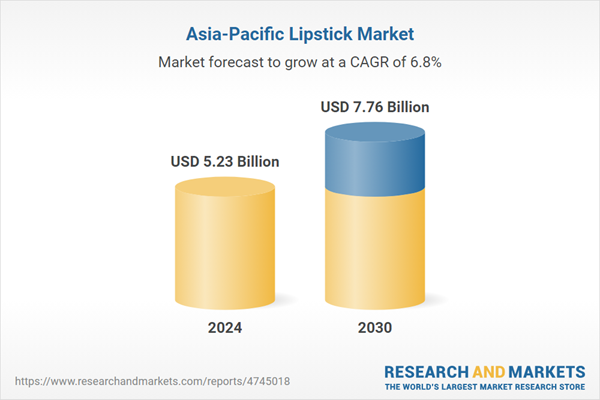Speak directly to the analyst to clarify any post sales queries you may have.
10% Free customizationThis report comes with 10% free customization, enabling you to add data that meets your specific business needs.
The market is segmented by distribution channels, including departmental and grocery stores, multi-branded retail stores, online platforms, supermarkets/hypermarkets, exclusive retail stores, and others, with online channels witnessing rapid growth due to convenience and a wider product range. Additionally, the rise of e-commerce giants and direct-to-consumer brands has expanded accessibility, especially in countries like China, India, and South Korea. In terms of product types, the market is divided into gloss, matte, and other variants, with matte lipsticks holding a dominant share due to their long-lasting effect and high pigmentation.
However, gloss products are regaining popularity, particularly among younger consumers, due to evolving trends favoring a dewy, natural look. Key growth drivers include the increasing demand for organic and vegan formulations, innovations in product textures and finishes, and celebrity endorsements that influence purchasing decisions. Moreover, the market is benefiting from rising male grooming trends, expanding the target consumer base. The premiumization of cosmetic products, fuelled by aspirational buying behavior, is also contributing to market expansion. Major players are investing in product innovation and localization strategies to cater to diverse cultural preferences across the region. With supportive government regulations on cosmetic safety and an increasing focus on sustainable packaging, the Asia-Pacific lipstick market is poised for steady growth in the coming years.
Market Drivers
Rising Disposable Income and Urbanization
One of the primary drivers of the Asia-Pacific lipstick market is the region's growing disposable income, particularly in emerging economies such as China, India, Indonesia, and Vietnam. In 2023, China's per capita disposable income reached 51,821 yuan, up from 49,283 yuan in 2022. In February 2025, the Indian government announced personal income tax cuts, raising the tax-free income threshold to 1.28 million rupees. This policy is expected to boost disposable income for an estimated 25-30 million people, allowing them to save about 100,000 rupees annually.Rapid urbanization has contributed to increased employment opportunities, especially for women, leading to higher purchasing power and a shift toward spending on non-essential goods, including cosmetics. As consumers become more financially empowered, there is a noticeable shift from budget-friendly products to premium and luxury brands. Urban centers are also hubs for fashion and beauty trends, further accelerating the demand for innovative and high-quality lipstick products. The rise in dual-income households and changing lifestyle patterns has also influenced purchasing behavior.
Consumers are now more inclined to invest in personal grooming and self-care, viewing cosmetics not just as beauty enhancers but as part of their daily routine. In addition, exposure to global beauty trends through international travel and social media has heightened demand for a diverse range of lipstick products, including specialized formulations like organic, vegan, and cruelty-free options. This surge in economic prosperity and lifestyle changes continues to fuel the overall growth of the lipstick market across the Asia-Pacific region.
Key Market Trends
Personalization and Customization of Lipstick Products
A growing trend in the Asia-Pacific lipstick market is the increasing demand for personalized and customizable products. Consumers are no longer satisfied with one-size-fits-all beauty solutions and are instead seeking products tailored to their individual needs, skin tones, and preferences. Brands have responded by offering customizable options, allowing customers to select specific shades, finishes (matte, satin, gloss), and even packaging designs. Technological innovations, particularly in augmented reality (AR) and artificial intelligence (AI), have played a crucial role in enabling this trend.Many beauty brands now offer virtual try-on tools through mobile apps and online platforms, allowing consumers to test different shades virtually before purchasing. This feature has been particularly successful in markets like China and South Korea, where tech-savvy consumers are driving e-commerce growth. Additionally, brands are introducing personalized lipstick formulations based on factors such as skin undertone analysis, lip hydration levels, and even climate-specific needs. This level of customization not only enhances the consumer experience but also helps brands foster loyalty in a market where competition is intense and consumer preferences evolve rapidly.
Key Market Players
- Parfums Christian Dior Société Anonyme
- CHANEL Limited
- Revlon Consumer Products Corporation
- The Estée Lauder Companies Inc.
- L'Oréal S.A.
- Shiseido Company, Limited
- Coty Inc.
- Beiersdorf Aktiengesellschaft
- Unilever PLC
- The Procter & Gamble Company.
Report Scope:
In this report, the Asia-Pacific lipstick market has been segmented into the following categories, in addition to the industry trends which have also been detailed below:Asia-Pacific Lipstick Market, By Distribution Channel:
- Departmental/ Grocery Stores
- Multi Branded Retail Stores
- Online
- Supermarkets/Hypermarkets
- Exclusive Retail Stores
- Others
Asia-Pacific Lipstick Market, By Product Type:
- Gloss
- Matte
- Others
Asia-Pacific Lipstick Market, By Country:
- China
- Japan
- South Korea
- India
- Australia
- Rest of APAC
Competitive Landscape
Company Profiles: Detailed analysis of the major companies present in the Asia-Pacific lipstick market.Available Customizations:
With the given market data, the publisher offers customizations according to a company's specific needs. The following customization options are available for the report.Company Information
- Detailed analysis and profiling of additional market players (up to five).
This product will be delivered within 1-3 business days.
Table of Contents
Companies Mentioned
- Parfums Christian Dior Société Anonyme
- CHANEL Limited
- Revlon Consumer Products Corporation
- The Estée Lauder Companies Inc.
- L'Oréal S.A.
- Shiseido Company, Limited
- Coty Inc.
- Beiersdorf Aktiengesellschaft
- Unilever PLC
- The Procter & Gamble Company
Table Information
| Report Attribute | Details |
|---|---|
| No. of Pages | 88 |
| Published | February 2025 |
| Forecast Period | 2024 - 2030 |
| Estimated Market Value ( USD | $ 5.23 Billion |
| Forecasted Market Value ( USD | $ 7.76 Billion |
| Compound Annual Growth Rate | 6.8% |
| Regions Covered | Asia Pacific |
| No. of Companies Mentioned | 10 |









